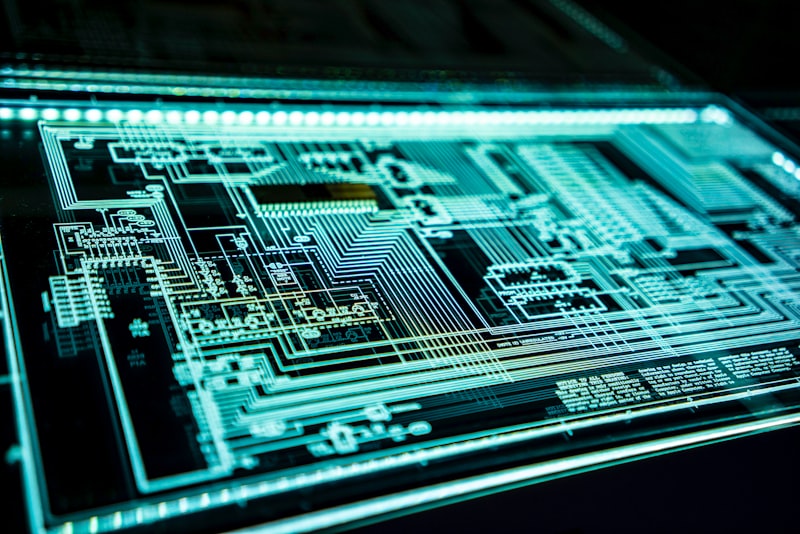Robotics and Automation Systems

In today’s fast-paced world, advancements in technology have led to groundbreaking innovations that are transforming industries across the globe. One such innovation is robotics and automation systems. These cutting-edge technologies have revolutionized the way we work, streamlining processes, increasing efficiency, and enhancing productivity like never before.
Imagine a world where repetitive tasks are no longer burdensome for humans. With robotics and automation systems, this dream has become a reality. These systems utilize intelligent machines to perform tasks with precision and speed, freeing up human resources for more complex and creative endeavors. From manufacturing plants to healthcare facilities, these systems have found their way into various sectors, proving to be game-changers.
One of the key benefits of robotics and automation systems is their ability to improve operational efficiency. By automating mundane and repetitive tasks, businesses can significantly reduce the margin for error and increase output. With robots tirelessly working round the clock, production rates soar, leading to higher profits and customer satisfaction.
Moreover, robotics and automation systems enhance workplace safety. Dangerous or physically demanding tasks can now be assigned to robots, reducing the risk of injuries and accidents for human workers. This translates into improved employee well-being and reduced insurance costs for businesses.
But it doesn’t stop there; these systems also contribute to cost savings. While the initial investment may seem substantial, the long-term benefits outweigh the expenses. By utilizing robots for tasks that were previously performed by humans, businesses can save on labor costs, lower turnover rates, and allocate financial resources towards research and development, further driving innovation.
Furthermore, robotics and automation systems pave the way for increased competitiveness in the global market. Businesses that adopt these technologies gain an edge over their competitors by offering products and services at competitive prices and with superior quality. Automation allows for faster response times, shorter production cycles, and the ability to adapt quickly to market demands.
Robotics and automation systems have transformed the way we work, offering numerous advantages that span across industries. From heightened productivity and improved workplace safety to cost savings and increased competitiveness, the impact of these technologies is undeniable. As we continue to embrace the era of automation, it’s important for businesses to recognize the immense potential that robotics and automation systems hold in shaping the future of work.
Revolutionizing Industries: How Robotics and Automation Systems Are Transforming Manufacturing Processes
Introduction:
In today’s fast-paced world, technological advancements continue to amaze us with their transformative potential. One such remarkable revolution is happening in the manufacturing industry, where robotics and automation systems are reshaping traditional processes. Gone are the days of manual labor dominating assembly lines; now, intelligent machines tirelessly perform complex tasks with precision and efficiency. This article explores how these advancements are driving innovation and streamlining manufacturing operations.
Efficiency and Precision:
Imagine a factory floor bustling with robots whirring away, each performing its designated task flawlessly. These mechanical marvels have brought unparalleled speed and accuracy to manufacturing processes. With their advanced sensors and programming, robots can repeatedly execute intricate maneuvers, minimizing errors and maximizing productivity. The result? Higher-quality products produced at a faster rate, leading to satisfied customers and increased profits for companies.
Streamlined Operations:
Automation systems have revolutionized the way factories operate. From material handling to inventory management, these systems seamlessly integrate various stages of production. Robots collaborate with human workers, taking care of repetitive and physically demanding tasks, freeing up valuable time for employees to focus on more creative and supervisory roles. By automating mundane processes, manufacturers can optimize resource allocation, reduce operational costs, and achieve higher levels of output.
Safety and Risk Mitigation:
Robots and automation systems play a crucial role in improving workplace safety. They excel in hazardous environments that pose risks to human employees, such as handling toxic materials or operating heavy machinery. By replacing humans in dangerous situations, robots help prevent accidents and minimize injuries. In addition, these intelligent machines are designed with sophisticated safety features, including collision detection sensors and emergency shutdown mechanisms, ensuring a secure working environment for all.
Adaptability and Flexibility:
One of the most remarkable aspects of robotics and automation systems is their adaptability to dynamic manufacturing needs. Machines can be easily reprogrammed and reconfigured to accommodate changes in product design or production requirements. This flexibility allows manufacturers to swiftly respond to market demands, launch new products faster, and stay ahead of the competition. By embracing these technologies, companies can future-proof their operations and remain agile in an ever-evolving business landscape.
Conclusion:
The Rise of Intelligent Machines: Exploring the Cutting-Edge Innovations in Robotics and Automation Systems
Have you ever wondered what the future holds for robotics and automation? Well, get ready to be amazed because the rise of intelligent machines is revolutionizing industries across the globe. In this article, we will delve into the cutting-edge innovations that are propelling robotics and automation systems to new heights.
Picture a world where robots seamlessly work alongside humans, performing complex tasks with precision and efficiency. This vision is becoming a reality thanks to advancements in artificial intelligence (AI) and machine learning. Intelligent machines are now capable of adaptive learning, enabling them to constantly improve their performance and adapt to changing environments.

One of the most exciting developments in robotics is the emergence of collaborative robots, also known as cobots. Unlike traditional industrial robots that were designed to work in isolation, cobots are designed to interact and collaborate with humans. These robots have advanced sensors and safety features that allow them to work safely alongside humans, enhancing productivity and efficiency in various industries such as manufacturing, healthcare, and agriculture.
Another groundbreaking innovation in automation systems is the integration of robotic process automation (RPA) with cognitive technologies. RPA involves automating repetitive tasks performed by humans using software robots. When combined with cognitive technologies like natural language processing and machine vision, RPA becomes even more powerful. Imagine a robot that can not only perform data entry tasks but also understand and interpret documents or images. This fusion of technologies has the potential to transform industries by streamlining workflows and minimizing errors.
Furthermore, the field of autonomous vehicles is rapidly evolving. Self-driving cars are no longer just a concept from sci-fi movies; they are being tested and deployed on public roads. These vehicles utilize advanced sensors, AI algorithms, and machine vision to navigate through traffic, making transportation safer and more efficient. Autonomous drones are also gaining traction, revolutionizing sectors like logistics, delivery services, and aerial inspections.
The rise of intelligent machines is reshaping the world as we know it. From collaborative robots to cognitive automation and autonomous vehicles, these cutting-edge innovations are propelling robotics and automation systems into the future. As technology continues to advance, we can expect even greater strides in the capabilities of intelligent machines, opening up new possibilities and transforming industries across the globe. So, buckle up and get ready to witness the incredible impact of intelligent machines in our everyday lives.
From Sci-Fi to Reality: Unveiling Breakthroughs in Robotics and Automation Systems
Have you ever wondered about the incredible advancements that have taken place in robotics and automation systems? It’s like stepping into a sci-fi movie, only this time it’s real! The field of robotics has witnessed remarkable breakthroughs, bringing us closer to a future where intelligent machines seamlessly integrate into our daily lives. Let’s delve into some of the awe-inspiring developments that have transformed science fiction into reality.

One area that has seen immense progress is autonomous vehicles. Imagine a world where cars drive themselves, reducing accidents and congestion on the roads. Companies are investing heavily in self-driving technology, utilizing artificial intelligence (AI) to navigate through traffic, interpret signals, and make split-second decisions. This innovation not only ensures safer transportation but also holds the potential to revolutionize logistics and delivery services.
Robotics has also made significant strides in the healthcare industry. Surgical procedures can now be performed with extreme precision using robotic-assisted surgery. Surgeons control robotic arms equipped with tiny instruments, enhancing dexterity and minimizing invasiveness. This breakthrough allows for quicker recovery times, reduced scarring, and improved patient outcomes.

Another exciting advancement is the emergence of humanoid robots. These intelligent beings resemble humans in appearance and behavior, and they’re becoming increasingly proficient at mimicking our actions. From assisting with household chores to offering companionship to the elderly, humanoid robots are gradually integrating into our daily lives. They possess the ability to recognize emotions, engage in conversations, and adapt to their environment, making them invaluable companions in the future.
Automation systems are also making waves across various industries. Manufacturing processes have become more efficient and cost-effective with the introduction of robotic automation. Robots equipped with advanced sensors and machine learning algorithms can perform repetitive tasks with unmatched speed and precision. This not only improves productivity but also frees up human workers to focus on more complex and creative endeavors.
As we witness these breakthroughs, it’s clear that the world of robotics and automation is rapidly evolving. The once far-fetched ideas portrayed in science fiction are now becoming tangible realities. From self-driving cars to humanoid robots, technology continues to reshape our lives, bringing us closer to a future filled with astonishing possibilities.
Enhancing Efficiency and Productivity: How Robotics and Automation Systems Are Reshaping Business Operations
Are you looking to revolutionize your business operations and boost efficiency? Look no further than the transformative power of robotics and automation systems. These cutting-edge technologies are reshaping the way businesses function, offering a wide range of benefits that can propel your company to new heights.
Imagine a world where repetitive and mundane tasks are seamlessly handled by intelligent machines, freeing up valuable time for your employees to focus on more strategic and creative endeavors. That’s precisely what robotics and automation bring to the table. By automating routine processes, you can streamline your operations, reduce errors, and significantly enhance productivity.

One of the key advantages of employing robotics and automation systems is their ability to work tirelessly, around the clock. Unlike human workers who have limitations, robots can operate non-stop, ensuring uninterrupted production. This means increased output, faster turnaround times, and ultimately, improved customer satisfaction. With automation, you can meet growing demands efficiently and stay ahead of the competition.
Another remarkable benefit is the precision and accuracy offered by these technologies. Robots are programmed to perform tasks with incredible consistency, minimizing errors and rework. This level of precision is particularly crucial in industries such as manufacturing and logistics, where even slight deviations can have significant repercussions. By incorporating robotics and automation, you can achieve superior quality control and deliver flawless products and services to your customers.

Furthermore, robotics and automation contribute to a safer working environment. Dangerous and physically demanding tasks can be assigned to robots, reducing the risk of workplace accidents and injuries. This not only protects your employees but also minimizes potential legal liabilities and associated costs. By prioritizing worker safety, you create a positive and nurturing workplace culture.
The integration of robotics and automation systems into your business operations can drive efficiency, increase productivity, and transform your organization’s overall performance. Embracing these technologies empowers you to optimize processes, eliminate bottlenecks, and unleash the full potential of your workforce. Stay ahead of the curve and embark on a journey towards operational excellence with robotics and automation. The future is here, and it’s time to embrace its transformative possibilities.




